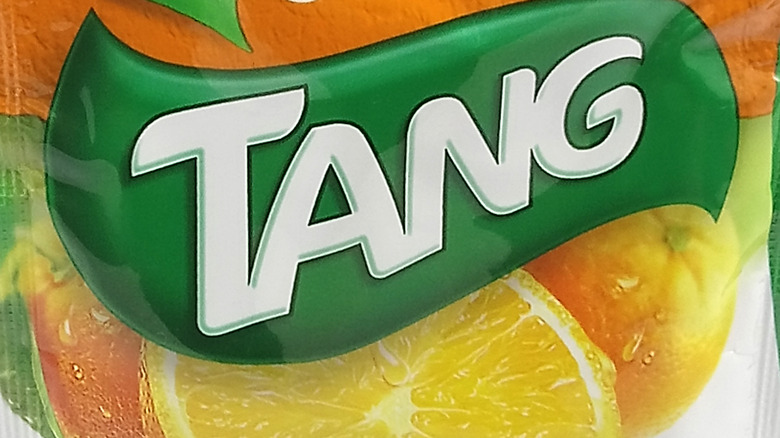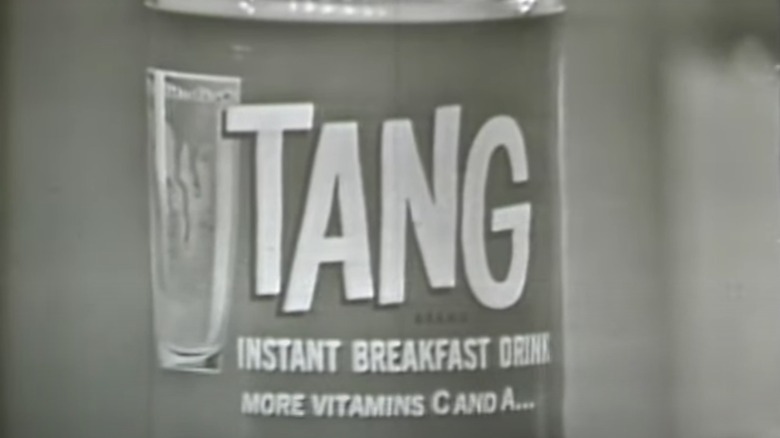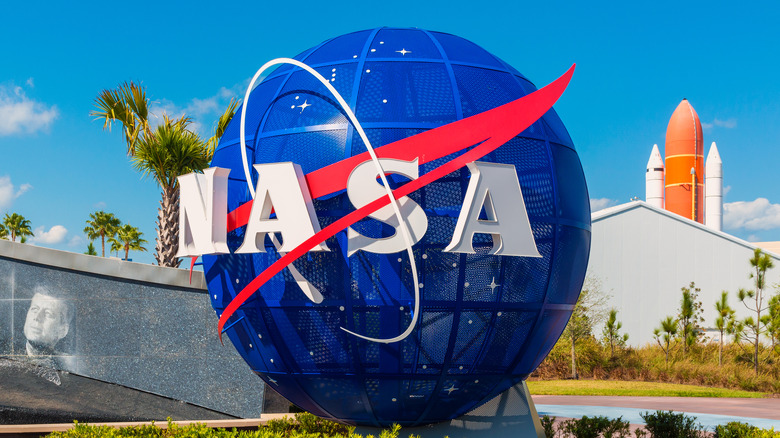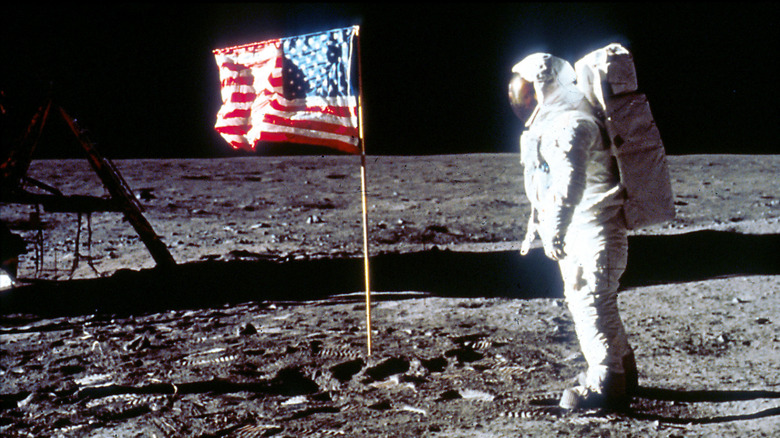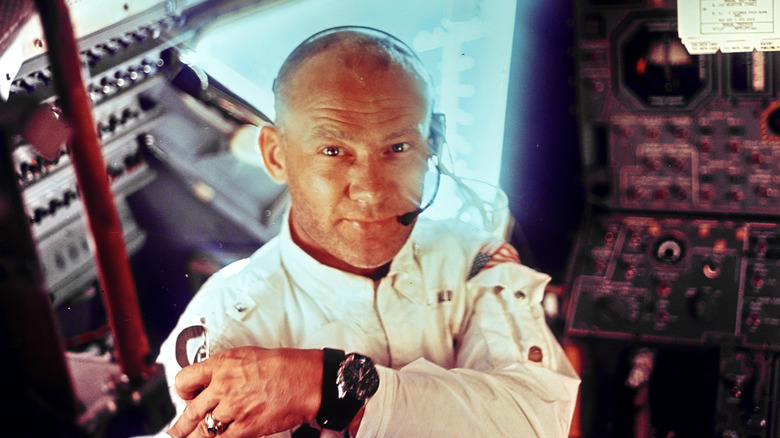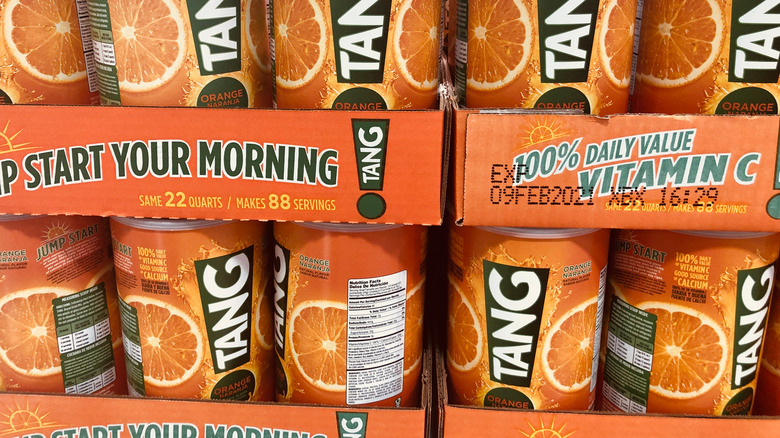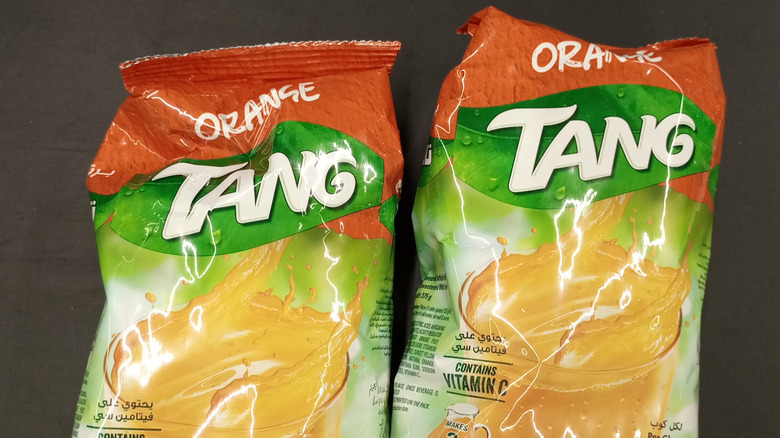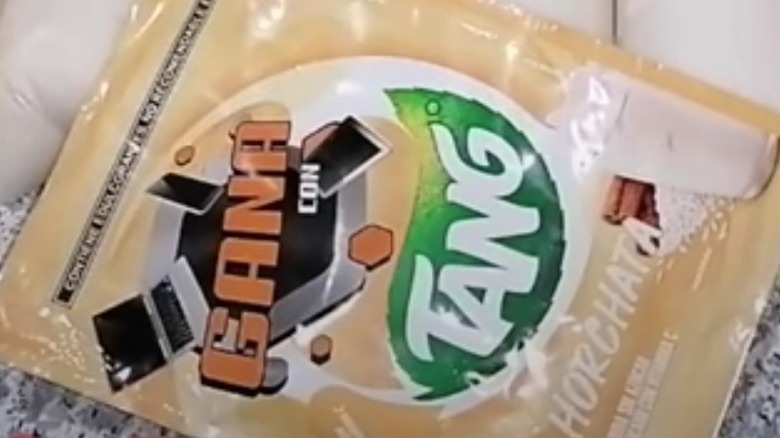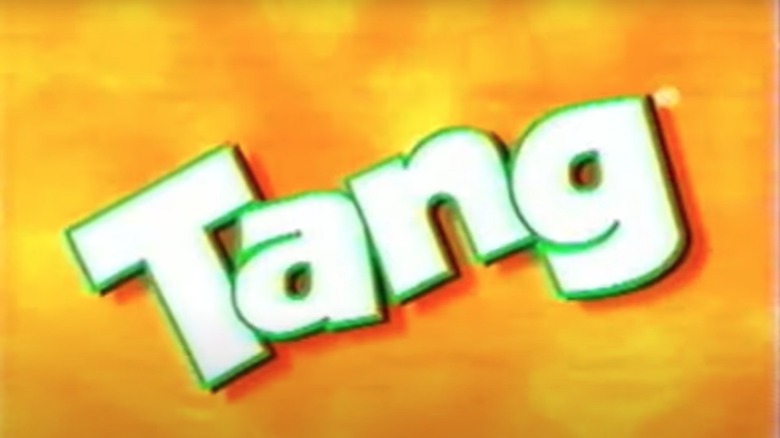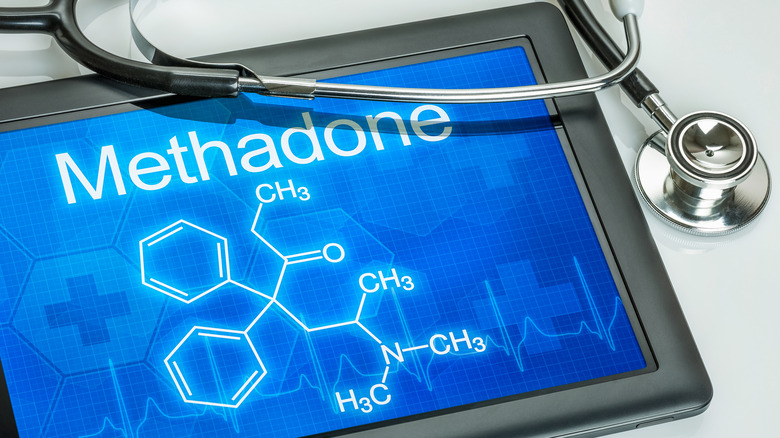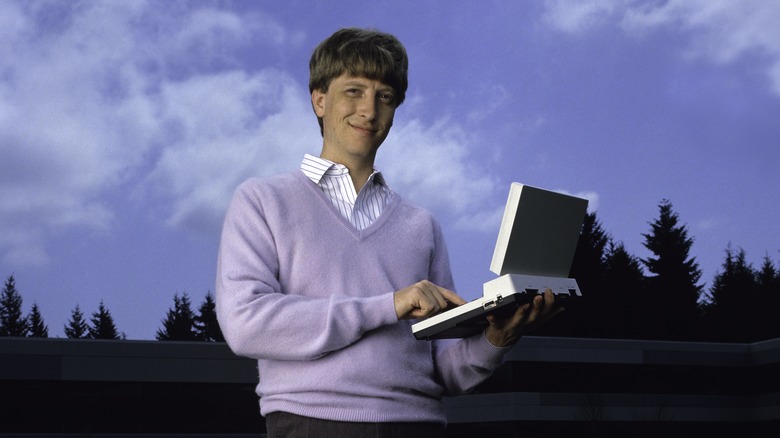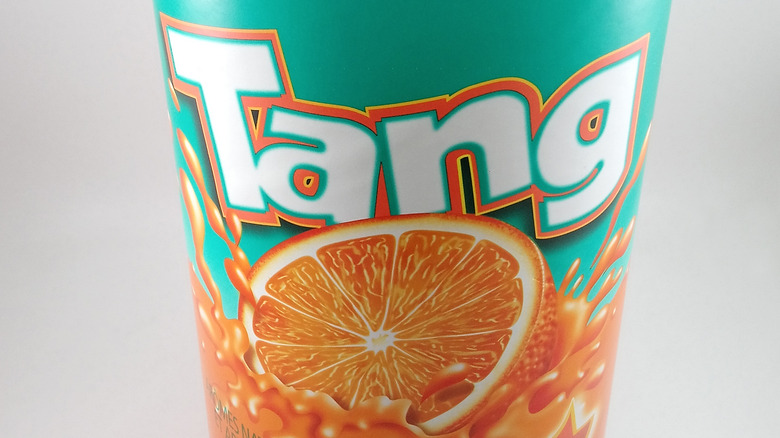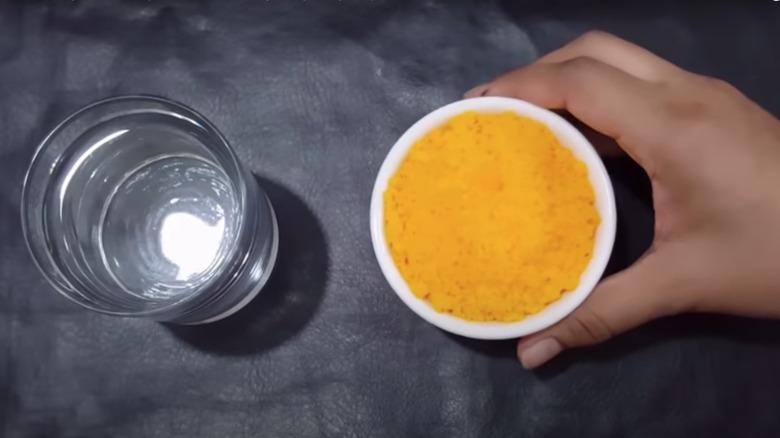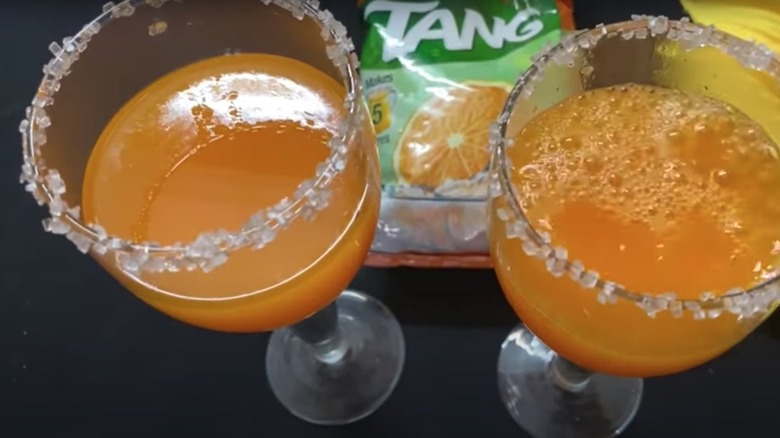The Untold Truth Of Tang
While not as ubiquitous as it once was, Tang has been a fixture at breakfast tables throughout the world well over a half-century. Launched by General Foods in 1959, Tang simulated the experience of drinking fresh-squeezed orange juice via the creation of a powder — dubbed "flavor crystals" — that could be mixed with water to create a juice-like beverage (via Food & Wine). The big selling point, as CNN pointed out, was that the powder was shelf-stable — meaning it could sit in a supermarket for far longer than actual orange juice — while containing even more vitamin C than the real thing. Heck, no less an authority than "Brady Bunch" mom Florence Henderson trumpeted the fact that "Tang has a full day's supply of vitamin C in every glass" in TV commercials.
Even though Tang may not be as popular in North America as it was during its peak in the 1960s and '70s, this powder-based drink continues to be a staple throughout the world. There's a lot more to this super-convenient thirst-quencher than meets the eye. To learn about the ins and outs of this drink's history, keep on reading to discover the untold truth of Tang.
Tang was invented by the creator of Pop Rocks and Cool Whip
Tang was the brainchild of General Foods food scientist William A. Mitchell. Mitchell, who died in 2004, who may not have been a household name, but the numerous products he invented sure did. As a profile in The Atlantic pointed out, Mitchell was also responsible for Cool Whip and the fizzy confection known as Pop Rocks, the latter more of a "happy accident" that resulted from a failed effort to create a carbonated powdered drink.
According to The Smithsonian, Mitchell began working at General Foods in the late 1930s, where he was tasked with creating a tapioca substitute for American troops fighting in the Pacific. The resulting concoction came to be nicknamed "Mitchell's mud" by the hungry soldiers who gobbled it up.
While chemical-filled, lab-developed food is far less popular than it was in days when consumers started their day with Tang, Mitchell earned his place in food history. As Marv Rudolph wrote in his book "Pop Rocks: The Inside Story of America's Revolutionary Candy," Mitchell was a "true inventor," someone "who looks at problems differently and can find elegant, sometimes simple solutions that no one else considered (via The Smithsonian).
It's a myth'that Tang was developed for NASA
Tang will always be associated with NASA, and for good reason: the beverage was among the comestibles that American astronauts took with them on their earliest manned missions. As a result, there's been a decades-long misconception that Tang was developed specifically for NASA.
The reality, however, is that Tang's association with NASA actually started after the drink was already in production. As Dr. Michele Perchonok, NASA's manager of the Space Food Systems Laboratory, told Space, it's a "myth" that Tang was created for astronauts by NASA. "The actual truth is [that] General Foods was making its travel drink mix and NASA thought, 'Oh, this is how we should be flying our beverages.' So we purchased the already made and commercially available product," she explained.
These days, astronauts mix and drink Tang (which isn't actually labeled as such on NASA missions) from an expandable mylar pouch that's sealed by a plastic valve, into which a single serving has been vacuum packed. An astronaut will then use a needle to inject water through that valve, shake up the pouch to mix it up, and then sip from a plastic straw.
However, it took NASA to make Tang cool
Tang is inextricably linked with NASA in public perception because that's the way Madison Avenue wanted it. As Discover pointed out, sales of Tang were sluggish until John Glenn sipped an orange beverage from a pouch during a 1962 Mercury mission. Suddenly, the slow-selling drink powder became the "space-age treat" that kids begged their moms to buy. Capitalizing on that, footage of space explorers started appearing in Tang commercials, such as a 1966 spot that proclaimed, "Tang: chosen for the Gemini astronauts." Thanks to NASA (and to canny advertisers), Tang had gone from a slow-selling product to a hit almost instantly.
General Mills continued to exploit that association with even more ads utilizing footage from NASA missions in Tang TV commercials, and in 1968 even sponsored TV coverage of the Apollo 8 moon mission. The culmination of this synergy was Tang's 1969 "For Spacemen and Earth Families" advertising campaign, which not only emphasized the association between Tang and NASA, but also led many to believe that it was NASA, and not a General Mills food scientist, that invented it.
Legendary astronaut Buzz Aldrin was not a fan of Tang
While astronauts did indeed drink Tang during all those NASA missions, did they actually enjoy it? At least one astronaut expressed his true feelings about Tang, reported TMZ, when Buzz Aldrin appeared at Spike TV's Guy's Choice Awards. He was presenting an award to Felix Baumgartner, an Austrian skydiver who made headlines and history by jumping from space, setting a Guinness World Record as the first person to have ever broken the sound barrier while in freefall.
According to TMZ, Aldrin admitted he was envious of Baumgartner's sponsorship deal with Red Bull, and that he'd never received a dime from any corporate sponsor for blasting off into space — particularly from Tang. Besides, he added as a punchline, "Tang sucks!"
Aldrin wasn't the only astronaut to have a dodgy relationship with Tang. When John Glenn — who eventually parlayed his NASA fame into a 25-year run as a U.S. Senator — mounted his first (unsuccessful) campaign for public office in 1970, he was frustrated that reporters asked about Tang rather than about his policy positions (via New York Magazine).
Tang's popularity faded in the U.S., but not overseas
Over the decades since Tang first hit supermarket shelves, American consumer preferences have changed considerably. Tang doesn't really fit into the healthy and natural food trends that are so popular in contemporary American culture. CNN noted in 2021 that the drink had become something of a "space-age relic" in the U.S.
However, that hasn't been the case outside the States, with Tang proving to be enduringly popular overseas. Per CNN, the product is not only popular throughout South America and parts of Asia, but also in the Middle East, where it sells particularly well during the fasting month of Ramadan.
According to Twin Cities Pioneer Press, Tang can be found in about 35 different countries and is particularly popular in Argentina, Brazil, Mexico, Saudi Arabia, and the Philippines. Meanwhile, as Fortune reported back in 2011, the United States, Tang's birthplace, didn't even make it into the top five most-popular Tang markets.
Tang is still a valuable brand
Despite having fallen out of favor with North American consumers, Tang remains a powerhouse in other parts of the world. According to a 2011 report from Fortune, international sales of Tang — which was then owned by Kraft — had doubled since 2006, with sales at that point exceeding a billion dollars a year. The Twin Cities Pioneer Press reported that the brand's sales remained strong in 2016, amounting to $900 million.
These days, the Tang brand is owned by Mondelez International, a company that Business Standard reported was "demerged" from Kraft Foods in 2012.
In 2013, Business Standard reported that the company hatched a plan to increase its popularity in the Indian market, which was dominated by similar drinks sold by local beverage manufacturer Rasna. In order to increase the visibility of Tang, Mondelez mounted an all-out promotional blitz throughout Indian "hypermarkets," with young men costumed as "Rocketmen" carrying containers of pre-mixed Tang which could be poured into a cup and offered to customers.
The frightening reason Tang should only be consumed in moderation
Interestingly enough, when Tang was first introduced into the marketplace in the late 1950s, one of the powdered beverage's big selling points was its high nutritional value, given that it was chock full of vitamin C. CNN reports that Tang was even marketed as being healthier than orange juice. Of course, Tang isn't just packed with vitamins; it'salso loaded with sugar. As the nutrition label shows, the first ingredient Tang lists is sugar, while the second is fructose — which, for the uninformed, is simply another form of sugar (via Target).
In fact, a 3-tablespoon serving of Tang powder, which makes a 12-ounce glass of the drink following the label instructions, contains 34 grams of added sugar — approximately two-thirds of the recommended daily limit.
Even worse, a 2012 study from the American Journal of Public Health noted that drinking too much fructose can lead to liver damage, metabolic syndrome, and obesity.
There are some unusual flavors of Tang throughout the world
Tang didn't become a billion-dollar international powerhouse by resting on its laurels. Focusing on the overseas markets where consumers took a shine to Tang, manufacturer Mondelez International sought to further entice those consumers by coming up with new flavors of Tang aimed at catering to the specific tastes of each country.
A Mondelez fact sheet lays it all out, listing all the various flavors of Tang available in assorted countries. In Argentina, for example, the standard orange flavor is joined by apple and orange-mango varieties, while Brazil offers grape and pineapple Tang. Mexican consumers, on the other hand, can quench their thirst with tamarind- and horchata-flavored Tang, along with orange-lemon and orange-mango hybrids.
In the Philippines, Tang is offered in even more unique country-specific flavors, including mango, pomelo, honey lemon, and guyabano, a.k.a. soursop, a South American fruit that is widely grown in the Philippines and known for allegedly medicinal properties.
A new tax increased the price of Tang in the Philippines
Tang has long been a favorite beverage choice of Filipino consumers, but that popularity was threatened in 2017 due to the introduction of a new federal tax. As ABS-CBN News reported, that was when the government of the Philippines instituted the Tax Reform for Acceleration and Inclusion law, known as the TRAIN law. The new law increased taxes on sugar-sweetened beverages. It had two goals: increasing tax revenue and reducing obesity and related illnesses such as diabetes. Beverages sweetened with sugar were taxed 6 Filipino Pesos per liter, while ones with high fructose corn syrup were taxed at double that rate.
The makers of Tang responded with a message on Facebook informing consumers that the new sugar tax had left the company with no alternative but to raise the price of Tang in the Philippines. However, the message added that they remained committed to "providing refreshment with the best value for money through delicious fruit flavors and exciting consumer promotions."
Tang was used to treat heroin addiction, but there were unintended consequences
According to a 1972 paper published in the medical journal Annals of Internal Medicine, Tang had been an integral part of treating heroin addiction when combined with methadone, a less-addictive synthetic opioid that served as a heroin substitute. As the paper explained, Tang was mixed with methadone and given to patients to drink in order to diminish their withdrawal symptoms.
There was a dark side to that strategy, the paper explained, when people seeking a more powerful high than could be achieved by drinking the Tang-methadone combo instead began injecting it into their veins. Not surprisingly, the health outcomes of consuming Tang intravenously were not good. In the paper, a patient is referenced who "developed medical complications after a series of such injections."
Despite those injection-related issues, Tang was still widely used in conjunction with methadone for years after that. A 2016 paper published in Substance Abuse Treatment, Prevention, and Policy pointed out that in 2014, patients in the Canadian province of British Columbia were being "transitioned" from "the oral liquid compound Tang-flavored methadone to the 10-times more concentrated cherry-flavored Methadose."
If you or anyone you know is struggling with addiction issues, help is available. Visit the Substance Abuse and Mental Health Services Administration website or contact SAMHSA's National Helpline at 1-800-662-HELP (4357).
Tang fueled the early development of Microsoft
Not only did Tang accompany astronauts into space, the powdered drink mix was also a key element in the creation of Microsoft, the computer software company that made Bill Gates one of the richest humans on the planet.
Gates made that revelation in the 2019 Netflix documentary "Inside Bill's Brain: Decoding Bill Gates." "I would buy a bottle of Tang, which is an orange sugary drink [mix] that they took to the moon that you know, instead of going to meals, I would just pour orange Tang on my hand and lick it off my hand as I was working on things," said Gates in the doc, as reported by CNBC. "So my face would be covered in this orange stuff."
According to Gates, swallowing Tang powder was a time-saving measure, explaining that "you can just skip the water because your body already has water in it and just lick it off your hand." Asked whether that caused the keys of his computer to become stained with orange-colored Tang powder, Gates admitted, "Ah, that's a problem, yup."
Tang has more uses than as just a beverage
For more than 60 years, the manner in which Tang has been used by consumers has been remarkably consistent: a spoonful of the powder is mixed into a glass of water and then consumed. However, Tang has another use that was revealed in a "Today" feature about unusual spring cleaning tips served up by lifestyle expert Elizabeth Mayhew.
Mayhew offered several helpful tips, which included clearing out clogged drains with a combo of baking soda and vinegar (the fuel for countless school science fair volcanos) and disinfecting kitchen sponges by running them through the dishwasher. Mayhew also suggested cleaning toilets by adding a teaspoon of Tang powdered drink mix into the toilet bowl, advising to let the powder sit in the bowl for a few minutes and then giving it a "swish" before flushing. According to Mayhew, the citric acid in the powder "acts like a scrubber."
Meanwhile, Joey Green's Wacky Uses for Brand Name Products shares even more unorthodox uses for Tang. According to Green, Tang can be used to dissolve warts, clean ovens, ease hangovers, remedy bad breath, shampoo hair, and even provide temporary relief from the symptoms of nicotine withdrawal (we have not tested any of these uses, so we can't guarantee their effectiveness).
There's a recipe to make homemade Tang
While Tang has a long history of being both affordable and widely available in stores, what if one is suddenly overcome with a hankering for a glass of Tang and there is none to be found? If that unlikely scenario were to occur, there are actually recipes that demonstrate how to concoct homemade Tang powder.
One such recipe from Bless My Food By Payal appears to be surprisingly easy to make, featuring a somewhat modest list of ingredients that include sugar, orange glucose, citric acid, orange food coloring, orange essence, and a pinch of salt. According to the instructions, the sugar and the citric acid (also known as tatri) are combined in a blender and ground together until the whole mixture becomes a fine powder. Then, the glucose, food coloring, orange essence, and salt are added. The powder is then blended again, resulting in a faux Tang that is now ready to be mixed with water and guzzled to your heart's content.
Tang has inspired some creative cocktails
There are some who are not content to merely drink Tang in the prescribed manner, with cocktail aficionados creating some inventive libations using the powdered drink mix. Arguably the least complicated of these is the Space Screwdriver, in which vodka is mixed with Tang instead of the traditional orange juice.
Then there's the Buzzed Aldrin, combining Tang, vodka, grenadine and club soda in a recipe courtesy of country singer/Food Network personality Tricia Yearwood. Meanwhile, the Tipsy Bartender website offers a recipe for the Tang Shot — a mixture of Tang, vodka and triple sec — and Cookpad has an alcohol-free Tang Cocktail that uses three flavors of Tang (regular orange, orange-mango, and pineapple) along with peach nectar, sugar syrup, and a pinch of salt.
Even more Tang-based cocktails can be found at the Bar None Drinks website, which lists an array of concoctions such as the Fuzzy Astronaut (combining orange Tang with vodka and peach schnapps), the Blue Iguana (made from 7-Up, Everclear grain alcohol, rum, vodka, and Tang), and the $2 Fish, consisting of Tang, grenadine, tequila and vodka.
